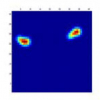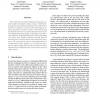CVPR
2006
IEEE
15 years 1 months ago
2006
IEEE
With the growing interest in object categorization various methods have emerged that perform well in this challenging task, yet are inherently limited to only a moderate number of...
CVPR
2006
IEEE
15 years 1 months ago
2006
IEEE
Geometric reconstruction problems in computer vision can be solved by minimizing the maximum of reprojection errors, i.e., the L-norm. Unlike L2-norm (sum of squared reprojection ...
CVPR
2006
IEEE
15 years 1 months ago
2006
IEEE
Coarse-to-fine classification is an efficient way of organizing object recognition in order to accommodate a large number of possible hypotheses and to systematically exploit shar...
CVPR
2006
IEEE
15 years 1 months ago
2006
IEEE
In this paper we demonstrate how Interval Analysis and Constraint Logic Programming can be used to obtain an accurate geometric model of a scene that rigorously takes into account...
CVPR
2006
IEEE
15 years 1 months ago
2006
IEEE
We describe a method to align ASL video subtitles with a closed-caption transcript. Our alignments are partial, based on spotting words within the video sequence, which consists o...
CVPR
2006
IEEE
15 years 1 months ago
2006
IEEE
This paper describes a novel approach to optimal kernel placement in kernel-based tracking. If kernels are placed at arbitrary places, kernel-based methods are likely to be trappe...
CVPR
2006
IEEE
15 years 1 months ago
2006
IEEE
We consider the important challenge of recognizing a variety of deformable object classes in images. Of fundamental importance and particular difficulty in this setting is the pro...
CVPR
2006
IEEE
15 years 1 months ago
2006
IEEE
Shrinkage is a well known and appealing denoising technique. The use of shrinkage is known to be optimal for Gaussian white noise, provided that the sparsity on the signal's ...
CVPR
2006
IEEE
15 years 1 months ago
2006
IEEE
CVPR
2006
IEEE
15 years 1 months ago
2006
IEEE
We address the image denoising problem, where zeromean white and homogeneous Gaussian additive noise should be removed from a given image. The approach taken is based on sparse an...


